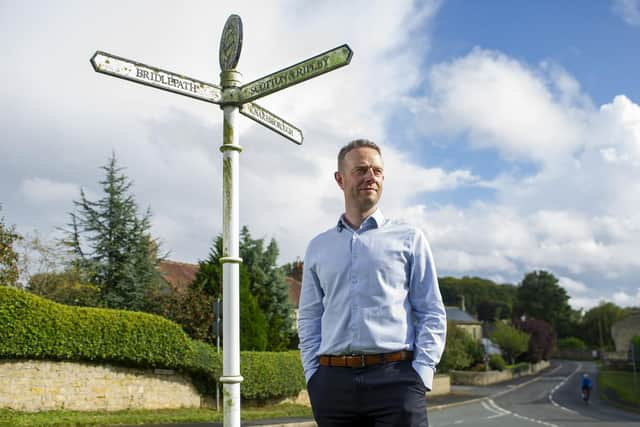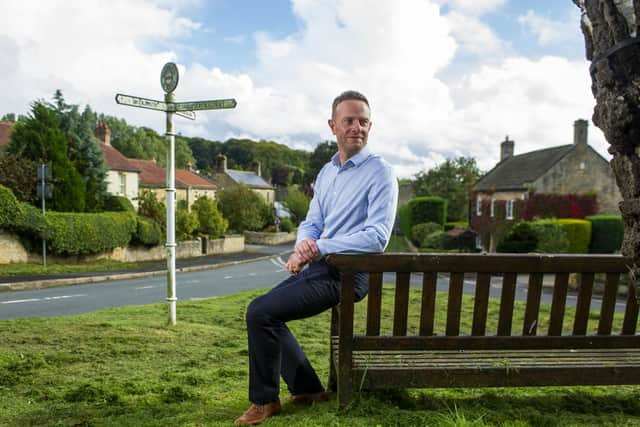Yorkshire's towns' 'huge opportunity' to make themselves fit for 21st century
A study of towns across North and East Yorkshire says the rise in remote working due to the pandemic has given places outside the major cities a chance to attract young workers.
But the report for the North and East Yorkshire Local Enterprise Partnership, seen by The Yorkshire Post, says towns must improve the quality of local broadband access, "which many businesses and residents find to be too slow."
Advertisement
Hide AdAdvertisement
Hide AdAnd the report's authors suggest public buildings like libraries could be used to teach young and old residents the vital digital skills that towns will need in abundance to thrive in the 21st century.
Better digital connectivity, new networks of cycle and walkways and revamped outdoor spaces for entertainment and socialising are among a raft of recommendations aimed at boosting the long-term fortunes of North and East Yorkshire towns.
It comes amid fears that the agreement of a devolution deal for North Yorkshire, which could see new powers and billions of extra funding invested locally, could be delayed due to the ongoing Brexit and pandemic uncertainty.
And the chairman of the area's Local Enterprise Partnership, created to boost economic growth, says the county could be consigned to “second division” status without the powers and funding that come from a devolution deal with central government.
Advertisement
Hide AdAdvertisement
Hide Ad

Kevin Fenning, Associate Director of Metro Dynamics, the economic consultancy group which produced the report, described it as a "blueprint for towns in Yorkshire to help them maximise the opportunities of the 21st century economy".
He said: "The internet is fundamentally changing global economic geography – allowing more and more people to work remotely and therefore bringing the modern professional services economy closer to places outside big cities, like Yorkshire’s towns."
Mr Fenning said the coronavirus pandemic provided towns with even more opportunities to promote their strengths through online channels to attract skilled residents in search of an improved quality of life.
And he added that smaller towns were increasingly being discovered by holidaymakers on staycation or workers looking to move out of cities.
Advertisement
Hide AdAdvertisement
Hide Ad

He said: “So there is a huge opportunity. There is also necessity. Many sectors have been badly affected by the pandemic.
"One of the few sectors still showing strong growth is the digital sector. Now more than ever it is vital to help local people – particularly young people – to gain the skills needed to work in this sector and other growing professional services sectors."
The vast majority of the 15 North and East Yorkshire towns featured in the report have seen a fall in their working age populations in recent years, a trend local leaders are aiming to reverse.
On the Yorkshire coast, leaders in Whitby are planning a 'free WiFi zone' between the town centre and the harbour as part of their bid to the Government's £3.6bn Towns Fund, as well as a new nature tourism scheme designed to "bring nature into the community".
Advertisement
Hide AdAdvertisement
Hide Ad

But the former leader of Scarborough council, Conservative Derek Bastiman, says high streets in the area and further afield will have to dramatically change their offer in years to come.
"Some people won't like me saying this but the high streets have got to contract," he says.
"They've got to shrink, have the high streets because they will not be what they were five, 10 15 years ago, secondary and third-trading areas need to go and be turned into residential properties, maybe.
"But the high street has got to contract and become more focused on where it is and become a real interesting place to go to shop, where interesting shops are, not usual run-of-the-mill shops."
Advertisement
Hide AdAdvertisement
Hide Ad'Teach online skills in libraries to help towns join the digital revolution'
Being based in the “picturesque historic market town” of Knaresborough has a number of obvious benefits for Oliver Smith, a manager at design, print and digital agency The Inter Group.
The firm has called Knaresborough home for a number of years and has taken advantage of its good commuter links as well as easy access to suppliers and to the skilled staff the firm needs.
“The town itself is a picturesque historic market town and it benefits the business to be located somewhere that customers enjoy visiting and can access easily,” Mr Smith tells The Yorkshire Post from his office in the outskirts of the town.
Advertisement
Hide AdAdvertisement
Hide AdNorth Yorkshire towns like Knaresborough, which have long been popular with tourists but less good at keeping and attracting young families, play a huge part in the economy of England’s largest county.
But though they vary in size and character, the majority face long-term challenges due to an ageing population, a declining working-age population and declining town centres.
And with the pandemic likely to bring about dramatic changes to the way we live and work in the coming years, leaders are being urged to think differently if they are to thrive in the 21st century.
A new report, commissioned by the York and North Yorkshire Local Enterprise Partnership, offers a host of recommendations as part of a blueprint for towns in North and East Yorkshire “to help them maximise the opportunities of the 21st century economy”.
Advertisement
Hide AdAdvertisement
Hide AdThe report, carried out late last year but published this month, identifies how the internet has fundamentally changed economic geography around the world by allowing more people to work remotely, meaning the modern professional services economy no longer has to be based in big cities.
Kevin Fenning of economic consultants Metro Dynamics, who wrote the report, said: “The internet also levels the playing field and allows greater opportunity for places to promote their strengths through online channels – to attract skilled residents and visitors.
“At the same time, modern knowledge workers want a high quality of life and Yorkshire’s towns are well placed to provide this. Over the past nine months, the COVID-19 pandemic has, if anything, accentuated these opportunities.
“Large swathes of the workforce – and, perhaps more importantly, the organisations they work for – have gotten used to working remotely, and found that in most cases it is as, if not more, effective than working in offices.
Advertisement
Hide AdAdvertisement
Hide Ad“The flurry of recent home-buying outside of major cities suggests that many people are making a permanent decision to swap city locations for smaller towns with better access to nature. With international travel curtailed – more people are rediscovering smaller towns and rural areas through staycations.”
His report identifies that the digital sector is one of the few going strong during the pandemic and that now more than ever it is vital to help local people - especially the young - gain the skills needed to work in this sector.
One major challenge for many towns in North and East Yorkshire is the quality of broadband access, which many businesses and residents find to be too slow. Work is underway to address this, with North Yorkshire County Council this summer embarking on phase four of its Superfast North Yorkshire project which has already brought high quality broadband to more than 180,000 homes and businesses throughout the county.
But there is still a long way to go. Of the 15 towns which feature in the report, only one had more than 12 per cent ultrafast connectivity as of 2018.
Advertisement
Hide AdAdvertisement
Hide AdKnaresborough, which has 77 per cent ultrafast coverage, will also along with Ripon benefit from the scheme to make nearby York the UK’s first ‘gigabit city’ with access to a city-wide full fibre broadband network offering lightning-fast internet speeds.
Oliver Smith of The Inter Group says his firm has a specific need for quick and reliable internet connectivity, adding: “We send and receive a lot of digital files in one form or another and a good connection speed is vital to us achieving an efficient level of productivity.”
He said: “Even though we are located on the outskirts of the town we are evidence that, with the right investment in the right technology, it is possible for businesses to benefit from very good connection speeds.”
The report suggests getting fibre connectivity to key public buildings - something already happening in some areas - is the first step in the process.
Advertisement
Hide AdAdvertisement
Hide AdThough this will require “a proactive communications policy that helps spread the positive messages of broadband investment and ensures that local people are prepared to deal with the temporary disruption of installing the infrastructure”.
But by achieving so-called ‘gigabit’ speeds of 900MB in towns will encourage inward investment and reinforce the message that these towns are ‘places of the future with strong heritage’, rather than ‘heritage places’, says the report. Equally as crucial to showing young people that they can stay in towns and don’t have to leave for major cities is giving them opportunities to learn vital digital skills locally.
The report says: “Helping local residents gain digital skills will be a crucial component of enabling young people in the towns to succeed, supporting mature workers to progress and retrain, and helping older residents to access services in the community.”
But the challenge is introducing skills such as programming, app development, digital media and data science at an early age and providing a friendly and approachable way of accessing them.
Advertisement
Hide AdAdvertisement
Hide AdThe authors suggest that skills training provision can be delivered from physical centres in larger towns, possibly including co-location of training services within libraries or other public buildings.
They add: “In smaller towns it might be harder to have dedicated facilities, but pop-up classes can be held in church halls etc. provided there is wi-fi available.”
The report focuses on 15 towns in North and East Yorkshire, including Bedale, Bridlington, Driffield, Knaresborough, Thirsk and Whitby, with each graded against a number of criteria including working age population, jobs, connectedness and the performance of the town centre.
The city of Ripon is rated lowest, largely due to an 8.9 per cent fall in jobs between 2011 and 2018, while Malton and Norton scored highest.
Advertisement
Hide AdAdvertisement
Hide AdNew networks of cycle and walkways and revamped outdoor spaces for entertainment and socialising, as well as the creation of enterprise centres to accommodate small businesses and start-ups, are among recommendations aimed at boosting their long-term fortunes .
And it suggest short-term measures to achieve these aims include forming towns futures teams including business representatives, residents’ groups and towncouncils to develop a local vision.
Local authorities should undertake town centre audits to help identify “quick wins” to improve town centre functions, like improved signage, lighting and basic street furniture.
“Going forward, it will be vital for local people – supported by the local authorities and the Local Enterprise Partnership – to take charge of this agenda in their towns,” says Mr Fenning.
“After all, a real strength of Yorkshire’s towns are its strong communities and local networks.”
Comment Guidelines
National World encourages reader discussion on our stories. User feedback, insights and back-and-forth exchanges add a rich layer of context to reporting. Please review our Community Guidelines before commenting.